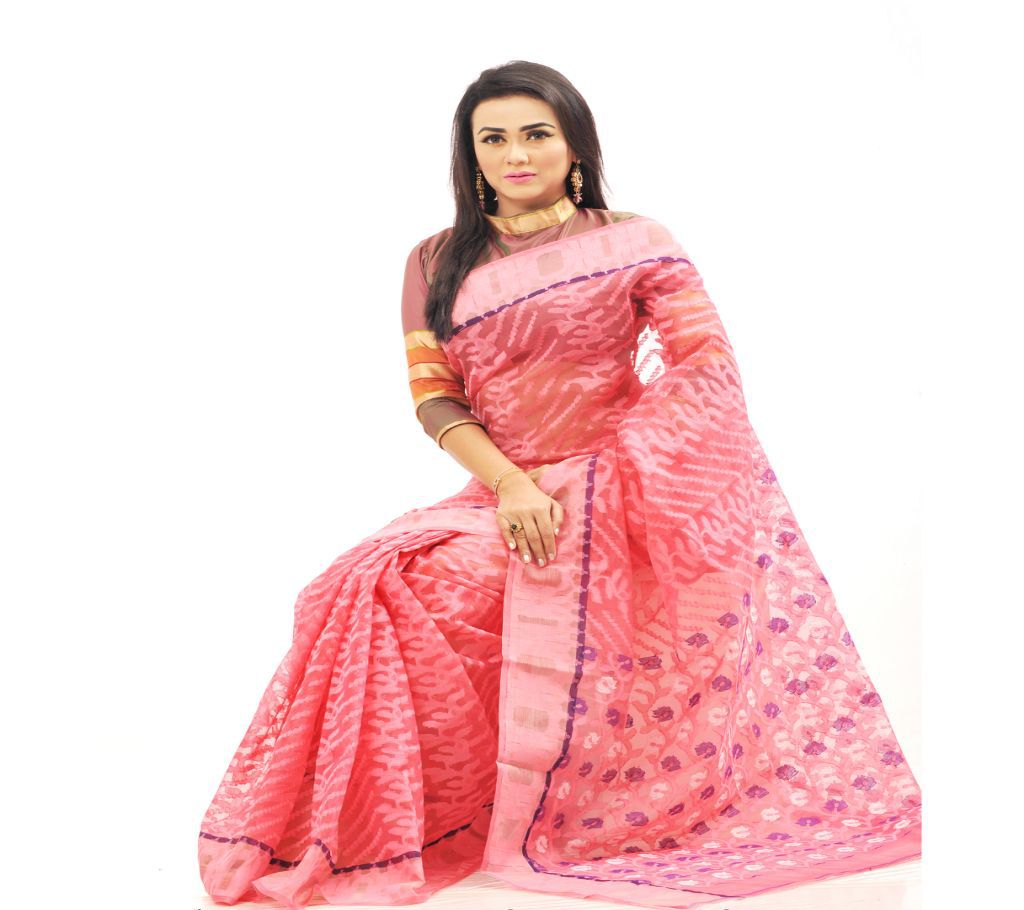Jamdani saree, a traditional handwoven fabric hailing from the heart of Bengal, India, is an exquisite masterpiece that has adorned women for centuries. With its intricate patterns, lightweight texture, and rich cultural heritage, the Jamdani saree holds a special place in the world of textiles.
1. Origin and History Jamdani’s origins trace back to the Mughal era, dating to the 17th century or even earlier. The word “Jamdani” has Persian roots, with “Jam” meaning flower and “Dani” signifying a vase, which perfectly captures the essence of its floral motifs.
2. Craftsmanship and Weaving Technique Skilled artisans use the discontinuous supplementary weft technique to create the Jamdani’s complex patterns. This method involves adding a supplementary weft to the base weave by hand, producing intricate designs and textures.
3. Luxurious Fabric and Yarns Jamdani sarees are woven with fine cotton, often mixed with gold or silver threads, creating a lustrous effect. The luxurious feel and lightness make it ideal for various occasions.
4. Captivating Designs One of the most striking features of Jamdani sarees is their elaborate and captivating designs. The motifs range from floral patterns, geometric shapes, and paisleys to mythological scenes.
5. Geographical Indication (GI) Tag Recognizing its cultural significance and craftsmanship, Jamdani received the Geographical Indication (GI) tag in 2013, protecting its heritage and promoting the artisans’ welfare.
6. The Evolution of Jamdani Over the years, Jamdani sarees have evolved to cater to contemporary tastes while preserving traditional elements.
7. Jamdani Revival In recent times, there has been a revival of interest in traditional crafts, and Jamdani has found renewed appreciation globally.
8. Cultural Significance Jamdani sarees are an integral part of Bengali culture, worn on various occasions, including weddings, festivals, and religious ceremonies.
9. The Weaving Process The intricate weaving process is time-consuming and requires immense skill, often involving a team of weavers.
10. Role of Artisans The weavers’ dedication and craftsmanship play a vital role in preserving the art of Jamdani weaving.
11. Challenges Faced by Artisans Despite its cultural significance, the Jamdani industry faces challenges, including competition from power looms and economic hardships.
12. Empowering Women Artisans The Jamdani industry provides opportunities for women to become skilled weavers, empowering them economically and socially.
13. Influence on Fashion Jamdani sarees have transcended regional boundaries and have made their mark in the international fashion scene.
14. Sustainable Fashion Choice The eco-friendly production process and use of natural materials make Jamdani a sustainable fashion choice.
15. Admired by Royalty and Celebrities Throughout history, Jamdani sarees have been favored by royalty and celebrated by Bollywood celebrities.
16. Preservation of Heritage Efforts are being made to preserve the traditional art of Jamdani weaving through workshops and training programs.
17. Global Appeal With its unique charm and timeless elegance, Jamdani has garnered admirers from around the world.
18. Modern Interpretations Contemporary designers have given a modern twist to Jamdani, making it relevant to the current generation.
19. Embracing the Legacy The demand for authentic, handwoven Jamdani sarees encourages the continuation of this exquisite legacy.
20. Conclusion The Jamdani saree stands as a testament to the artistic brilliance and rich heritage of Bengal’s weaving tradition. Embracing its charm is not just embracing a fabric but a story woven with threads of history, culture, and craftsmanship. Let us cherish and sustain this timeless treasure of Bengal, passing it down to generations to come.
Regenerate response
You may also like
-
Tyler The Creator: Redefining Style and the Rise of the Tyler The Creator Hoodie
-
Experience True Craftsmanship with a Custom Tailor in Bangkok
-
Indian Wedding Outfits That Make You Shine – Explore Bombay Trendz
-
Office to Party: 7 Ready-To-Wear Sarees That Move With Your Day
-
The Meaning Behind Mad Happiness

